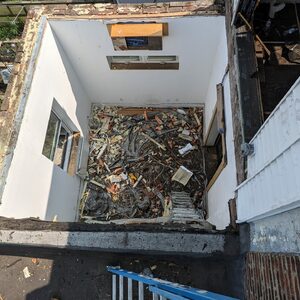*
I’m in the middle of plans to turn the first floor of my 22′ x 22′ barn into a usable 4 season shop – currently no heat. I’m in Boulder, CO which is more mild than most people think, but certainly below freezing at night. The ceiling height is 7′ (oh so sad!). I have 110 and 220 power. The space is somewhat divided into smaller spaces. Three walls are stone and the front is wood. The whole place is in rough shape and may get a major renovation in the next ten years. Does anyone have suggestions for a cheap to install and run system that I wouldn’t mind tossing out when I reno the place (in the future I’ll run nat. gas to the barn)? Certainly baseboard comes to mind, but I’m looking some alternatives. Thanks, I really value your input!
Discussion Forum
Discussion Forum
Up Next
Video Shorts
Featured Story

New devices showcased at the Builders' Show make it easy to measure glass performance, u-factor, SHGC, window thickness, and more.
Featured Video
How to Install Exterior Window TrimHighlights
"I have learned so much thanks to the searchable articles on the FHB website. I can confidently say that I expect to be a life-long subscriber." - M.K.
Fine Homebuilding Magazine
- Home Group
- Antique Trader
- Arts & Crafts Homes
- Bank Note Reporter
- Cabin Life
- Cuisine at Home
- Fine Gardening
- Fine Woodworking
- Green Building Advisor
- Garden Gate
- Horticulture
- Keep Craft Alive
- Log Home Living
- Military Trader/Vehicles
- Numismatic News
- Numismaster
- Old Cars Weekly
- Old House Journal
- Period Homes
- Popular Woodworking
- Script
- ShopNotes
- Sports Collectors Digest
- Threads
- Timber Home Living
- Traditional Building
- Woodsmith
- World Coin News
- Writer's Digest


















Replies
*
I would get a propane-fired or dual fuel suspended unit heater (about $570) and a 30 gallon portable tank to run it. Set it in a corner out of the way where you could vent it out the wall and have some place to store the tank.
An electric version (7.5 kW, 240 VAC) would be easier to install and cheaper to buy (about ($460) but more expensive to operate in most of the US.
*And later, when you pour the new slab, put radiant tubes in the floor.Tim's suggestion will work for you in the mean time if you can install some kind of path for the warmed air to reach each of the "somewhat divided into smaller spaces". Convection might work well enough (a hole at the top and bottom of the dividing walls), or you may add a helper fan in the upper hole to get more flow.The thermal mass of the stone walls will probably make it feel more cool in there than your heated air temp indicates. If you can put some insulation over them that'll help (but stone looks so awesome it is hard to bring one's self to cover it all up!). Maybe you can try one winter without it before you decide about that (after all, that's what sweaters are for).
*Thanks for the great advice. I'll probably go all electric and suffer the higher use costs. I've done a little homework and see that a 7.5 kW model puts out about 23,891 BtuH. Since I know next to nothing regarding heating needs for a given space, do you think this is the best size? I also see models at 3kW (10,239 BtuH), 5kW (17,065 BtuH), 10kW (34,130), and 15kW, 51,195 BtuH). I will probably follow Kerr's advice regarding the fans in the wall for circulation. Where might I find rules of thumb for BtuHs per cubic foot needs? Thanks again.
*A rule-of-thumb for an uninsulated space with fairly leaky air infiltration (ceiling above, that wooden wall, maybe the stone walls) would be 2 to 3 BTU per square foot of floor space per degree F temp difference.So if your are designing for 20F outside, 70F inside, have 484 square feet, then you'll need (484 x 50 x 2) = 48,000 BTU/hour to 72,000 BTU/hour. I'd go on the high side because you need to get all that rock warm. Not an issue if you keep it warm. But as a shop, you'll save a lot if you turn the heat on an hour before you use it and off again when you leave. In that mode, maybe electrical costs are tolerable. Note that you should confirm that you've got the required amperage at 220 volts (72,000 BTU/hour = 21 kw = 95 amps at 220 volts). And those 95 amps are in addition to whatever you are using in the house.Also check the ratings of electric heater carefully. If it is rated at 240 volts (most are), then you'll need to derate them 16% (i.e. multiple the wattage by 0.84) for 220-volt operation. Not a huge deal, but it may bump you up to the next size unit.What about a wall-mount unit that can converted from propane to natural gas? Run off a portable tank or propane-company-provided tank until you get the natural gas extended. You'll probably have to foot the bill for that extension but in a few areas, the gas company will assist you (cause you'll be using more of their product). And they are cheaper per foot than anyone else. -David
*I'm currently building a new shop, my first. standard 8' ceiling is much cheaper but it seems that 9' would be benifical. how important is this issue, should I spend the money? [email protected]